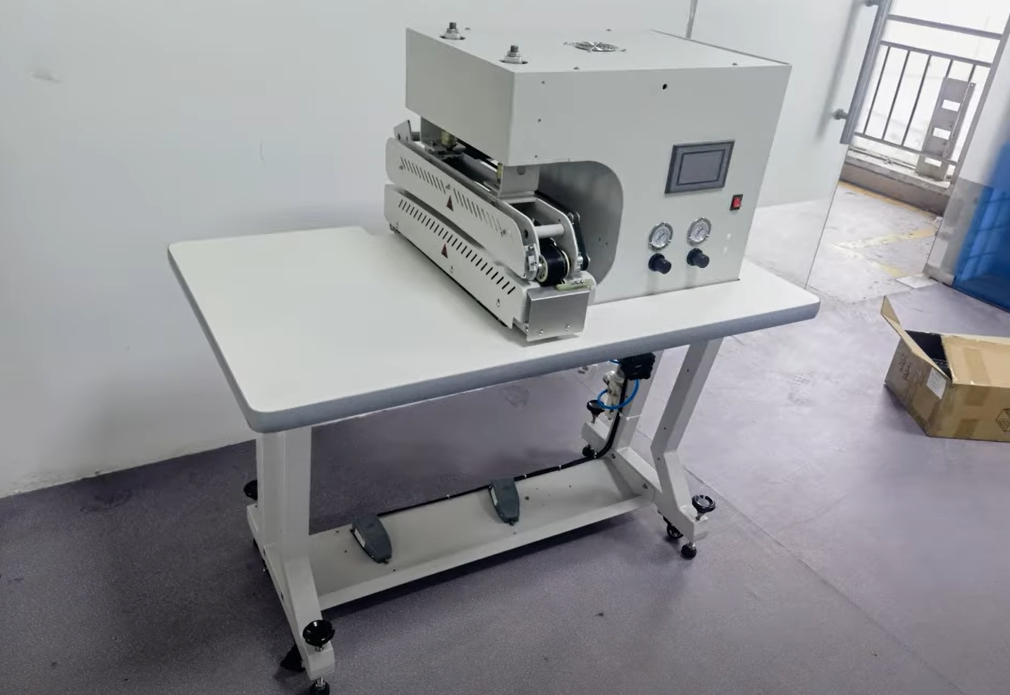In the modern garment manufacturing industry, efficiency, precision, and versatility are key drivers of competitiveness. Among the many specialized machines used in apparel production, the hemming machine plays a critical role in ensuring that garment edges are finished neatly, securely, and with a professional appearance. Whether producing sportswear, lingerie, casual clothing, or formalwear, hemming is an essential step in fabric processing.
With the rise of seamless garment manufacturing and advancements in automation, hemming technology has evolved far beyond traditional sewing methods. One prime example of this evolution is the belt style hemming sewing machine, such as the AT-212 model, which offers advanced features for high-speed and high-quality hemming using hot melt adhesive films instead of conventional thread stitching.
In this article, we will explore the importance of hemming machines in the garment industry, different types of hemming technologies, the specific advantages of modern belt style hemming machines, and how innovations like the AT-212 are shaping the future of apparel production.
1. Understanding Hemming in Garment Manufacturing
1.1 What Is Hemming?
Hemming refers to the process of folding the edge of a piece of fabric and securing it in place to prevent fraying while providing a clean, finished appearance. It is typically applied to the edges of sleeves, pant legs, skirts, t-shirts, curtains, and many other textile products.
Traditionally, hemming has been done with a hemming sewing machine that stitches the folded edge with a straight or cover stitch. However, in recent years, technology has introduced alternative bonding methods, such as hot melt adhesive films and heat sealing, which eliminate visible stitching for a seamless look.
1.2 Why Is Hemming Important?
Prevents fraying – Keeps fabric from unraveling during wear and washing.
Improves durability – Secures the garment’s structural integrity.
Enhances aesthetics – Creates smooth, even edges with a professional finish.
Adds comfort – Seamless hems reduce chafing and irritation.
Supports branding – High-quality hems reflect overall garment quality, which influences customer perception.
2. Types of Hemming Machines
Hemming machines vary based on their operating mechanism, purpose, and type of fabric they handle. The main categories include:
2.1 Traditional Hemming Sewing Machines
These use thread stitching to secure the folded fabric edge. Examples include:
Single needle lockstitch hemming machines
Coverstitch hemming machines
Overlock machines with hemming capability
Advantages:
Familiar technology
Suitable for a wide range of fabrics
Lower equipment cost
Limitations:
Visible stitching
Slower than automated belt systems
Limited to thread-based bonding
2.2 Chainstitch Hemming Machines
Commonly used for jeans and heavy fabrics, chainstitch machines offer a decorative stitch pattern and strong seam but are less suited to lightweight seamless garments.
2.3 Hot Melt Adhesive Hemming Machines
These machines use a heat-activated adhesive film to bond the hem without thread. The AT-212 is a perfect example, featuring:
Upper and lower feeding belts
Independent belt speed control
Precision temperature and pressure adjustments
Advantages:
Seamless appearance
Strong bonding without needle holes
Ideal for sportswear, swimwear, and technical garments

3. The Shift Toward Seamless Garment Production
The apparel industry has seen a growing demand for seamless garments, particularly in the sportswear and underwear segments. Seamless hems provide:
Enhanced comfort – No seam ridges against the skin.
Improved aesthetics – Smooth, modern look without visible stitching.
Better performance – In activewear, reduced chafing enhances mobility and endurance.
Belt style hemming sewing machines like the AT-212 align perfectly with this trend, offering manufacturers the flexibility to meet modern consumer expectations while maintaining production efficiency.
4. The AT-212 Belt Style Hemming Machine: A Case Study
4.1 Technical Specifications
Film type: Hot melt adhesive film
Feeding: Upper and lower fabric feeding belts
Speed: 0–150 mm/second
Presser foot: Air cylinder driven
Foot lift: 10 mm
Compressed air pressure: 0.5 MPa
Air consumption: 5–12 L/min
Power: 2100W
Voltage: Single-phase 220V
Net weight: 100 kg
Packing size: 133 × 66 × 138 cm
These specifications show that the AT-212 is built for industrial-scale production with precise control over feeding, pressure, and temperature.
4.2 Key Features
Independent upper and lower belt adjustment for perfect fabric and film alignment.
Intelligent fault detection for early problem alerts.
Temperature difference alarm to maintain bonding quality.
High temperature protection for operator and machine safety.
Flexible pressure control for different fabric thicknesses.
4.3 Production Benefits
Higher efficiency – Continuous feeding belts reduce downtime.
Consistent quality – Independent temperature control ensures uniform adhesion.
Material versatility – Works with various fabrics and adhesive films.
Energy efficiency – Optimized air and heat management reduces waste.
5. How a Belt Style Hemming Sewing Machine Works
The process typically follows these steps:
Setup and Inspection – Ensure the belts, heating system, and air pressure are functioning.
Temperature and Air Adjustment – Match settings to material specifications.
Belt Speed Control – Adjust independently for upper and lower belts for perfect alignment.
Material Loading – Place fabric and adhesive film onto feeding belts.
Bonding Process – Heat activates adhesive while belts apply pressure for a firm seal.
Finishing – Output hemmed garment edges ready for the next production step.
6. Comparing Belt Style Hemming Machines with Traditional Hemming Sewing Machines
| Feature | Belt Style Hemming Machine | Traditional Hemming Sewing Machine |
|---|---|---|
| Bonding Method | Heat + adhesive film | Thread stitching |
| Appearance | Seamless | Visible stitching |
| Speed | High, continuous feed | Moderate |
| Maintenance | Requires cleaning of belts and heating units | Requires needle and thread changes |
| Fabric Damage Risk | Low (no needle punctures) | Possible needle damage on delicate fabrics |
| Application | Sportswear, swimwear, lingerie, seamless garments | General garment production |
7. Applications in the Garment Industry
7.1 Sportswear and Activewear
Athletic garments benefit from seamless hems that reduce friction and improve comfort during movement.
7.2 Swimwear
Adhesive-bonded hems maintain elasticity and shape in water environments.
7.3 Lingerie
Smooth hems enhance comfort and luxury feel, especially in delicate fabrics.
7.4 Outerwear
Seamless hems offer wind resistance and water repellency benefits.
7.5 Casualwear
T-shirts, polo shirts, and dresses gain a clean, modern finish with heat-bonded hems.
8. Maintenance and Best Practices
Regular belt cleaning to prevent adhesive buildup.
Temperature calibration to match fabric and film requirements.
Air pressure checks to ensure consistent presser foot operation.
Preventive maintenance schedule to avoid unexpected downtime.

9. The Future of Hemming Machines in the Garment Industry
The industry will likely see:
Increased automation with AI-based fault detection.
Eco-friendly adhesives to meet sustainability goals.
Integration with cutting and sewing lines for fully automated production cells.
Smart monitoring for real-time quality control.
Conclusion
The hemming machine has evolved from a basic sewing tool into a high-tech production system that enables faster, cleaner, and more versatile garment finishing. Models like the AT-212 belt style hemming sewing machine represent the cutting edge of this evolution, offering seamless bonding technology that meets the growing demand for comfort, aesthetics, and performance in modern apparel.
For manufacturers aiming to stay competitive, investing in advanced hemming technology is not just an upgrade — it’s a strategic move toward higher productivity, better quality, and greater design flexibility.
